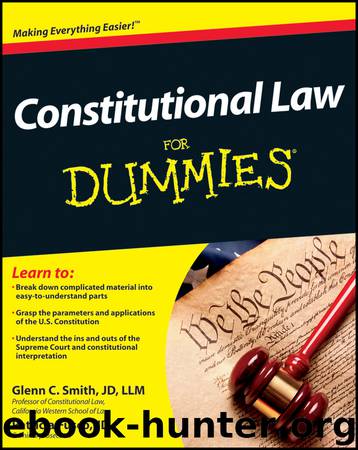Constitutional Law For Dummies by Smith

Author:Smith
Language: eng
Format: epub
Publisher: Wiley
Published: 2011-11-16T05:00:00+00:00
United States Trust Company v. New Jersey, 431 U.S. 1 (1977), illustrates this more-skeptical approach. The Court took a very dim view of efforts by New Jersey and New York to void agreements they made just 12 years earlier when floating government bonds. (At that time, to provide financial assurances to major lenders, the states had agreed to bond provisions limiting their ability to use public funds to subsidize mass transit.) The Court warned that “a State cannot refuse to meet its legitimate financial obligations simply because it would prefer” to follow a different public policy. The Court viewed “total repeal” of public-funding restrictions as not essential in light of “less drastic” alternatives available (including contract modification).
Taking Aim at Rights of Gun Ownership: The Second Amendment
The right to bear arms — which immediately connects to the right to buy and own weapons — is perhaps one of the most hotly debated topics related to property ownership (and indeed, to constitutional law generally) in the modern era. Gun-control activists are constantly at odds with gun-ownership-rights activists. Some Americans think gun-control laws will reduce crime in this country, particularly in the wake of horrific crimes such as children taking guns to schools and killing other students and teachers. But other people hunt as a major hobby, and some people carry guns or keep them in their homes for protection.
The general belief of an individual gun-ownership right stems from the Constitution’s Second Amendment, which states: “A well regulated Militia, being necessary to the security of a free State, the right of the people to keep and bear Arms, shall not be infringed.” Although this provision may seem simple on its face, constitutional interpretation is rarely cut and dry; every word, every clause and every comma, semicolon and period is dissected to the point of exhaustion.
Before 2008, Second-Amendment rights — although undoubtedly a perennially hot political issue — seemed a relatively dormant area of constitutional law. The conventional understanding was that the constitutional prohibition against infringing the “right of the people to keep and bear Arms” didn’t grant important individual gun-ownership rights (as compared to the right to own guns in order to participate in “[a] well-regulated Militia”) and that the Second Amendment only limited the federal government.
Two Supreme Court decisions in 2008 and 2010 drastically changed the constitutional playing field for gun rights. This section sketches in the conventional understanding these decisions disturbed, explains the holdings and rationale of the Court’s recent about-faces, and briefly summarizes issues the Court has not yet decided.
Understanding the previous era’s limited view about gun rights
Although for years many people have adamantly claimed a strong constitutionally guaranteed right to own a gun, until very recently the Second Amendment was viewed for several reasons as a limited constitutional provision.
First, the Second Amendment remained one of the few Bill of Rights provisions not officially incorporated and applied to state and local governments. The Court declined to incorporate this amendment in two very old cases, United States v. Cruickshank, 92 U.S. 542 (1876) and Presser v.
Download
This site does not store any files on its server. We only index and link to content provided by other sites. Please contact the content providers to delete copyright contents if any and email us, we'll remove relevant links or contents immediately.
Day by Elie Wiesel(2249)
The Age of Genius by A. C. Grayling(2175)
Gideon's Spies: The Secret History of the Mossad by Gordon Thomas(1955)
The Gulag Archipelago (Vintage Classics) by Aleksandr Solzhenitsyn(1730)
FATWA: Hunted in America by Pamela Geller(1724)
Columbine by Dave Cullen(1500)
Examples & Explanations: Administrative Law by William F. Funk & Richard H. Seamon(1332)
The Rule of Law by Bingham Tom(1320)
Men Explain Things to Me by Rebecca Solnit(1316)
Anatomy of Injustice by Raymond Bonner(1270)
Three Cups of Tea by Greg Mortenson(1261)
ADHD on Trial by Michael Gordon(1243)
That Every Man Be Armed by Stephen P. Halbrook(1241)
Gideon's Spies by Gordon Thomas(1218)
Palestinian Walks by Raja Shehadeh(1144)
The Source by James A. Michener(1137)
Fast Times in Palestine by Pamela Olson(1122)
Nothing to Envy by Barbara Demick(1042)
Constitutional Theory by Carl Schmitt(1038)
